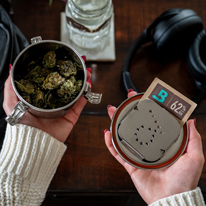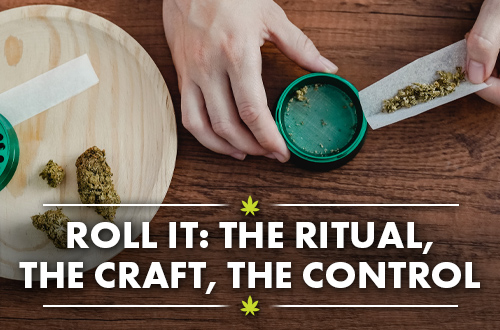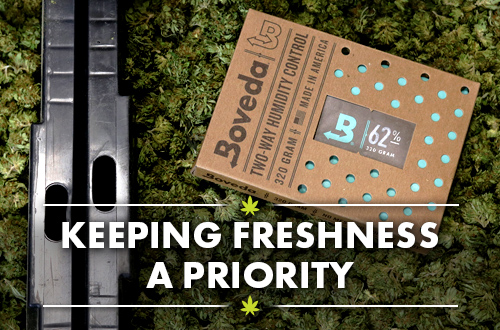Home Grow chronicles Dianna’s personal journey as a medical cannabis patient who registered and was approved by the Canadian government to grow cannabis in her home. Dianna’s experience is one grower’s point of view. Her ideas are neither the best or only proven methods for growing medicinal grade cannabis.
Moves are hard for everyone—even cannabis plants. Boveda blogger Dianna Donnelly transplants her girls for the final time. Read why too many changes at once can stress out vulnerable new residents.
My parenting friends complain of something all of the time that I never thought I’d experience. You buy a kid new shoes and before you know it, she’s outgrown them!
Well, my cannabis plants have outgrown their digs, again. My girls’ increased size and root growth warrant a move to their final destination in three gallon pots. Although my girls are growing up and out, they still feel like babes to me.
Rhiza is Greek for Root
We above-ground beings exist in our atmosphere. A similar space surrounding a plant’s roots is called a rhizosphere.
When roots start physically growing their curious extensions, they absorb and exude microbes and chemicals into and out of the new soil. In fact, roots are social butterflies!
You might think leaves are the most social part of a plant because that’s what we see and touch. Roots, however, make friends quickly and easily with soil through symbiosis. Figuratively speaking, roots build community, friendship and camaraderie by bringing feel-good snacks to the picnic.
Once in new soil, roots:
1. Exude “rhizadeposits” of:
- Sloughed-off plant cells;
- Mucilage (plant mucous); and
- Exudates (saps, gums, latex and resins).
2. Attract microbial communities, so they can break down those organic and inorganic compounds and use them as food.
It’s a serious “I’ll scratch your back, if you scratch mine” relationship between roots and soil. The increased nutrient availability make a rhizosphere the place to be!
Let’s Root Around My Home Grow
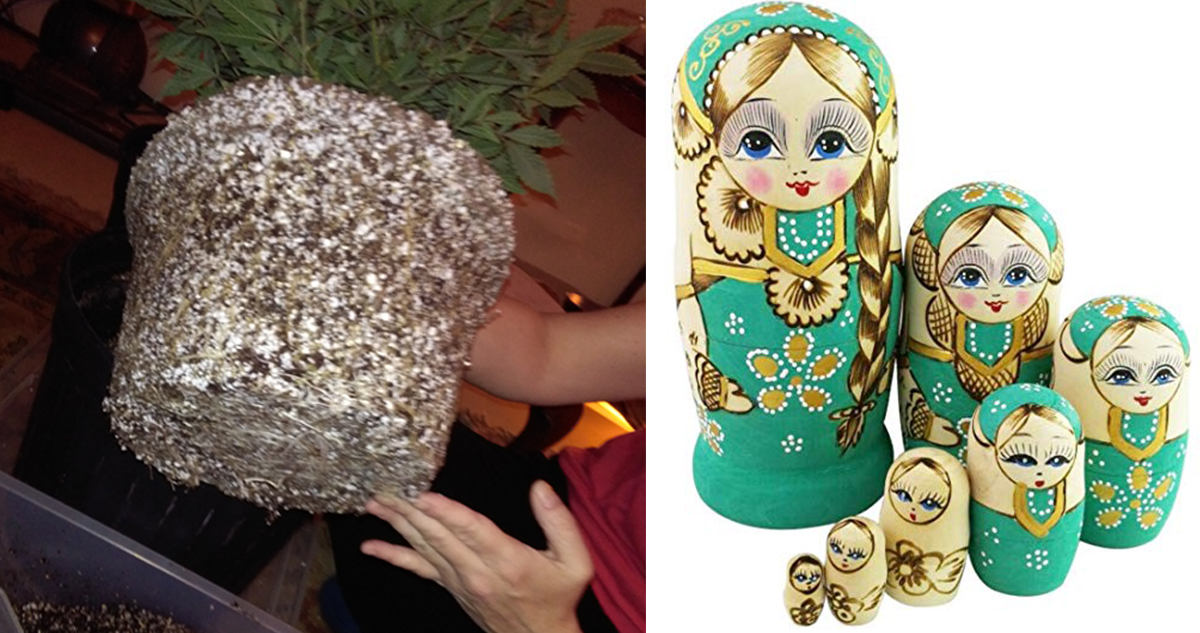
Following my own advice, I didn’t water the girls before I transplanted them, so their root structures stayed firmly intact. As a result, I was able to inspect each root mass after I gently coached it from the old container.
The root structure retained the shape of its container. I prodded the delicate roots with my finger. Carefully, I was able to push between two roots to feel soil just under the surface. Although difficult to see, I could feel another shell of roots, which resembled the shaped of its previous container.
Each root shell reminded me of a Russian nesting doll. Rootage doll nestled within a rootage doll. The idea that roots adapt and grow so quickly and effectively thrilled me.
GETTING TO THE ROOT OF ROOTS
The growth of a plant’s roots is deceptive because there is more than one part to this uber-important structure.
As you can see in the illustration below, each seed begins its growth by pushing a root-tail out of its shell. That delicate white structure is the taproot. It wastes no time searching for nutrients by growing straight down.
As the taproot grows, many subsidiary rootlets sprout horizontally from this dominant root. To the naked eye, they look like intricate hairs.
For clones however, no taproot exists. Clones have a “fibrous root system.” These two very different structures do very similar things. They both anchor the plant, so it can grow up toward a light source, including the ultimate grow light, the Sun. Both a fibrous root system and a taproot feeds the plant water and nutrients.
Which is better—fibrous system or taproot? Many growers believe seeds will always grow a bigger, healthier plant. Following the bigger-is-better logic, a larger plant would theoretically have larger plant “vessels” that could transport nutrients more efficiently. In plants, these vessel-like structures are called xylem and phloem.
In fact, both seeds and clones can produce humongous plants when given proper light, nutrients and care.

SEEDS FOR OUTDOOR GROWS
If growing cannabis outdoors is legal where you are—and you have the room and the right climate—starting from seed might be a better choice for you. In the ground, taproots can grow as deeply as they want. Just visualize how far an outdoor plant’s roots could travel versus in the confines of a plastic planter. It makes me want to stretch my legs just thinking about it!

CLONES FOR INDOOR GROWS
If you can legally cultivate indoors, clones might be a better choice. A fibrous root system doesn’t require a deep bed.
I’ve successfully grown cannabis indoors and out. (Although my outdoor plants were in pots and not in that great planter called Earth.)
Some farmer friends in my hometown have grown monsters in the back 40. The soil is teaming with microbes and organic nutrients. Because of the superior conditions and ample room to grow, those clones turn into Cannabis Ents!
HOW BIG IS MY POT?
I’m using three gallon pots because they were the largest ones I could find. When I attended the Lift & Co. Cannabis Expo in Toronto, I met some home growers cultivating plants in 10 and 20 gallon planters! There are also specialized planters with big holes in them for extra aeration. And if plastic isn’t your thing, you can plant your cannabis in a cloth or aluminum planter.
TRANSPLANTING CANNABIS: THE FINAL FRONTIER
This is the third time I’ve transplanted my little darlings. I’ve followed the same process:
- Filled the bottom of each new larger container with fresh soil mix
- Added a plant to each container
- Tucked soil around the root mass
THE STRESS OF MOVING
Repotting is a major transition for a plant. Imagine you’re a cannabis clone. You’re growing away, workin’ like a photosynthesis machine, pushing out as many leaves as you can and BAM. You’re rehomed.
Instinct (plus auxins or plant hormones) tells you to do a switcheroo. No longer is your energy going toward leaf production. Now your focus is on your roots. They immediately start exploring and growing to “ground” you for future growth. (Think tree pose in yoga. You can’t hold the pose or extend your arms into branches without first securing a strong, grounded base—four points of each foot ROOTED to the ground.)

Tree pose in the great outdoors with yogi Coleen Elwood, founder of Peace Medicine in Minneapolis.
NAMASTE, NOW BACK TO CANNABIS
One mistake home growers often make is exposing repotted plants to too many changes at once. For example, transplanting cannabis plants and changing their lighting all in the same day.
Doing too much at once totally confuses the plant. Now the auxins must divide the plant’s energy. Push itself to do two crucial functions simultaneously. This multitasking results in poor leaf and bud production and a weaker plant structure.
After each transplant:
- I allowed my girls two weeks to adapt to their new surroundings. This gave their roots, the brain of the plant, a chance to investigate their new environment.
- For 14 days, I fed them from the top once a day.
- I supplemented their water for the first week with Botanicare Liquid Karma®, which contains “metabolically active organic compounds.”
- Two days later, I “fed” them their usual vegging nutrients—Botanicare Pure Blend Pro® Grow.
- After two weeks, I started watering my plants from the bottom again. Adding water to the drainage plate forced the roots to reach or grow to absorb the water and nutrients. Thus, strengthening that foundation.
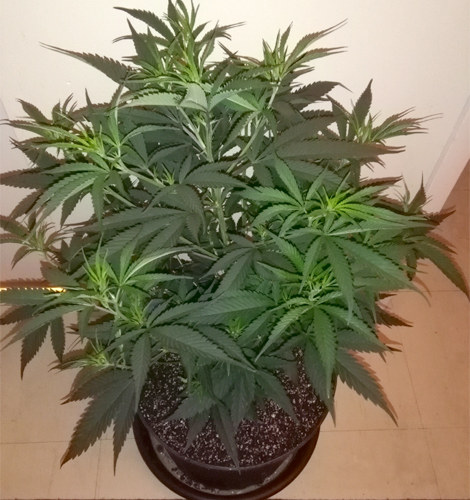
The girls are close to flowering! This last good nitrogen-rich feeding ensures one last punch of growth before that great transition to bloom.
Setting up these magnificent plants to grow to their fullest potential is my purpose these days. Tending to something helps me build my self-esteem and self-worth! With each and every stage in this awesome growing experience, I’m fostering skills that better me, heal me. Each botanical lesson strengthens my knowledge and my resiliency.
Some questions that popped up that I’m researching for future posts:
1) Does the “Russian doll action” hinder the plant’s successful growth?
2) Do the roots of clones have to work harder with each transplant versus the roots of seeds started in a large planter?
3) Does the struggle in a plant’s early life, make it stronger and more resilient?
– Dianna Donnelly

Dianna Donnelly is a cannabis educator, blogger, and freelance writer living in Kingston, Ontario. She counsels new patients on the safe and effective use of medicinal cannabis and believes that with enough time, cannabis, and coconut oil she can heal the world.
Dianna Donnelly’s posts are being provided for informational purposes only; they do not constitute an endorsement or an approval by Boveda of any of the products, services or opinions of Dianna Donnelly. Boveda bears no responsibility for the accuracy, legality or content of this post or links to the posts. Contact Dianna Donnelly for answers to questions regarding her content.
Home Grow #5: Topping & Cloning


